St. Patrick’s Day, science and candy all in one perfectly simple science activity for kiddos to try this season. Our Skittles Rainbow Experiment is a fun twist on a classic science experiment. Why taste the rainbow when you can SEE the rainbow! Quick results make it super fun for kids to observe and try over and over again.
SKITTLES RAINBOW EXPERIMENT FOR ST PATRICK’S DAY!
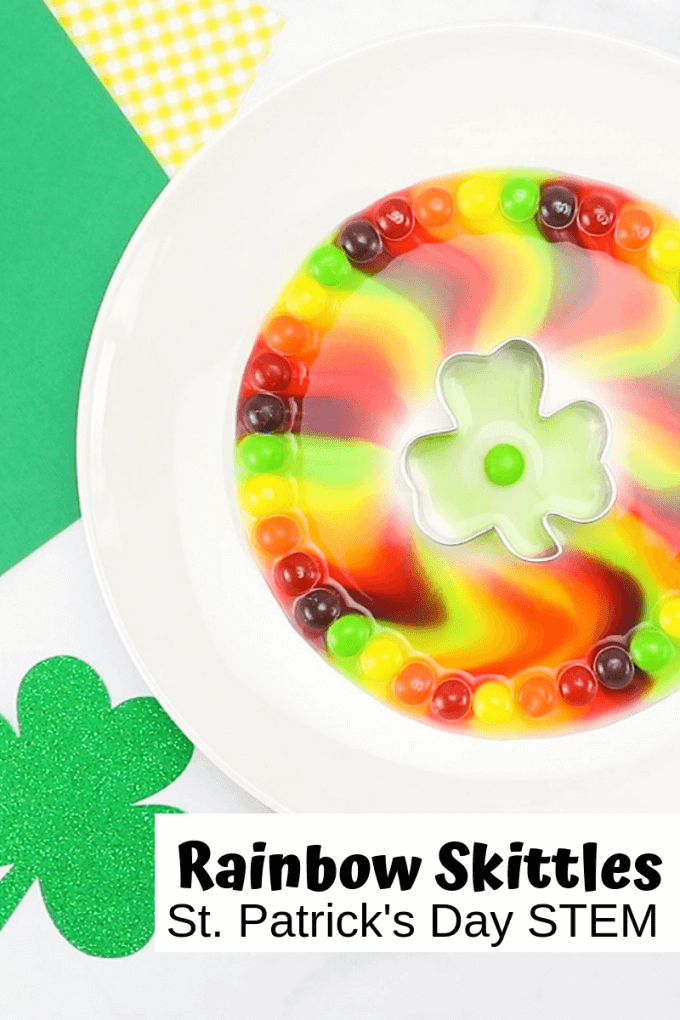
SKITTLES RAINBOW FOR ST. PATRICK’S DAY
Of course, you need to try out a skittles science experiment for St. Patrick’s Day! Do you remember our original Skittles Experiment? I thought it would be fun to give the kids a shamrock theme science activity so we changed up the original a bit with colors and patterns.
Our St Patrick’s Day Skittles Rainbow experiment is an awesome example of water density, and kids love this fascinating candy science project! Our candy science experiment uses a classic candy, Skittles! You could also try it with M&M’s and compare the results! Check out our floating M’s here too.
EASY ST. PATRICK’S DAY SCIENCE ACTIVITY!
We have a whole season of fun St. Patrick’s Day activities to try. Repeating experiments in different ways for young learners really helps to solidify understanding of the concepts being presented. Holidays and seasons present numerous occasions for you to re-invent some of these classic science activities like this Skittles Rainbow Experiment.
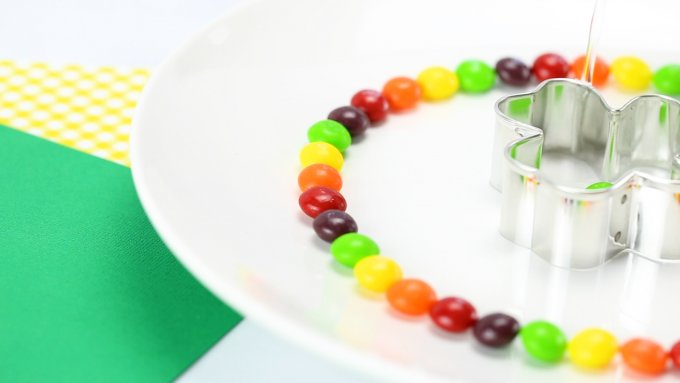
SKITTLES RAINBOW EXPERIMENT
You will want to set this experiment up where it won’t be bumped into but where you can easily watch the process unfold! Kids will have so much fun creating their own arrangements and patterns with the skittles. You should definitely have multiple plates handy!
YOU WILL NEED:
- Skittles Candy in rainbow colors
- Water
- White Plates or Baking Dishes (flat bottom is best)
- Shamrock Theme Cookie Cutters
Click below to get your quick and easy STEM challenges.
A variety of new activities, which are engaging and not too long!
SKITTLES RAINBOW SET UP:
- Set out a bowl of skittles or you can let the kids sort them out themselves!
- Let your child have fun arranging them in a pattern around the edge of a plate alternating colors in any number they like- singles, doubles, triples, etc…
- Pop in a St. Patrick’s Day shaped cookie cutter to the center of the plate just to add a little more of the theme and some additional color.
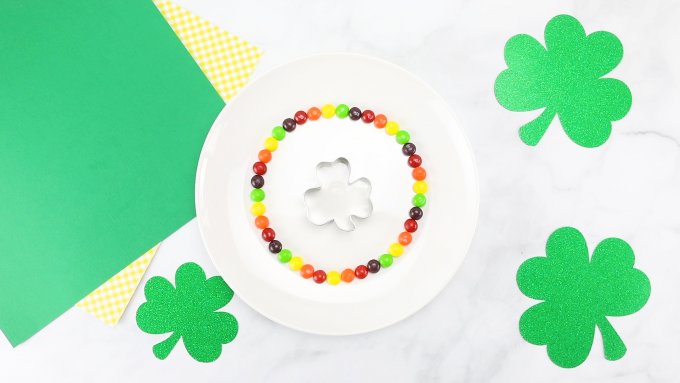
- Before pouring in the water ask your child to form a hypothesis. What will happen to the candy when it is wet?
This is a great time to work in a little deeper learning, you can find information to teach your child about the scientific method here.
- Carefully pour water into the center of cookie cutter until it just covers the candy. Be careful not to shake or move the plate once you add the water or it will mess up the effect.
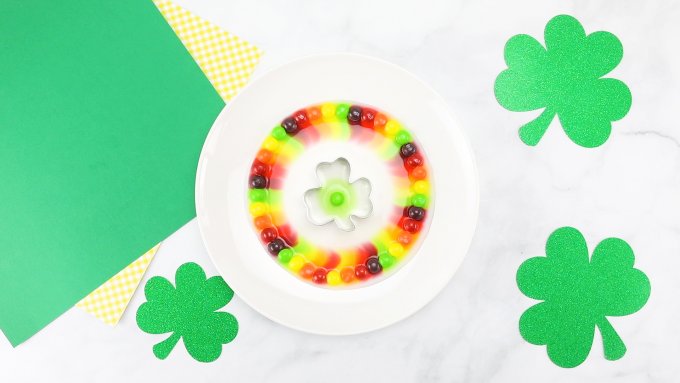
Watch as the colors stretch and bleed out away from the Skittles, coloring the water. What happened? Did the Skittles colors mix?
Note: After a while, the colors will begin to bleed together.

SKITTLES RAINBOW VARIATIONS
You can also try arranging the Skittles into a St. Patrick’s Day theme shape like a hat or rainbow! It’s a great hands-on activity for kids of multiple ages to enjoy (especially if there’s a bit of tasting involved). Remember you can try this with M&M’s too and compare or contrast the results.
You can easily turn this into an experiment by changing some variables. Remember to only change one thing at a time!
- You can experiment with both warm and cold water or other liquids like vinegar and oil. Encourage the kids to make predictions and carefully observe what happens with each one!
- Or you could experiment with different types of candies.
WHY DON’T THE COLORS MIX?
This Skittles Rainbow experiment demonstrates a process called stratification. The simple definition is that stratification is the arrangement of something into groups.
While we were looking up information about stratification online some sources said that each color of Skittles have the same amount of food coloring that is being dissolved off the shell and so as it spreads it doesn’t mix when they meet. You can read about this concentration gradient here.
Click below to get your quick and easy STEM challenges.
A variety of new activities, which are engaging and not too long!
CHECK OUT MORE ST PATRICK’S DAY SCIENCE:
Easy Leprechaun Trap Ideas For Kids
St Patrick’s Day Green Slime Recipe
Leprechaun Trap Mini Garden Activity
St Patrick’s Day Fizzy Pots Activity
Popsicle Stick Catapult For St Patrick’s Day STEM
St Patrick’s Day Science Discovery Bottles
Your kids will love this Skittles Rainbow Experiment!
We have the best in St. Patrick’s Day science if you click here or on the image below.


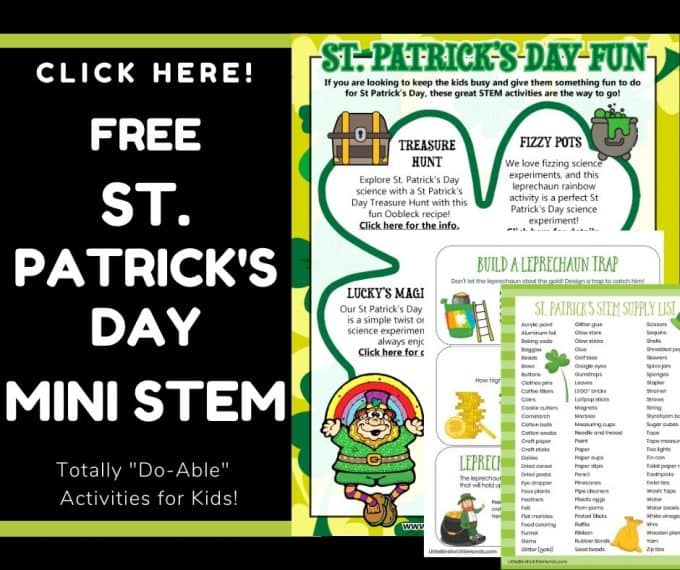







One Comment
Comments are closed.